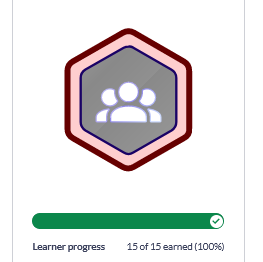
Spotlight Series - Rees Rankin
Instructors are always thinking about new ways to engage students. Some may try different classroom activities, others different types of assignments or projects. After frustration with student performance and a general lack of growth or success in some areas of his course, Professor and CME Lab Director, Rees Rankin, has taken to using Canvas Credentials in his classes.
Instructors are always thinking about new ways to engage students. Some may try different classroom activities, others different types of assignments or projects. After frustration with student performance and a general lack of growth or success in some areas of his course, Professor and CME Lab Director, Rees Rankin, has taken to using Badgr, now known as Canvas Credentials, in his classes, using it to encourage participation and mastery.
Fig 1. Canvas Credentials dashboard view of progression in course against available badges. Specific dashboard view shows completion rate based on 15 students enrolled in this course's section/CRN.
Credentials is a tool that integrates with Canvas, allowing instructors to provide digital badges to their students. Rees has implemented the tool into his CHE 495 course, chemistry’s first senior-level capstone laboratory course. “In this context, Credentials is being used as a competitive, rewards-based incentivizing tool to help facilitate and increase mastery and participation in both various soft-skill as well as some other informational skill and programming-related elements of the course required for data analysis and modeling. Rees has shared that, “As an example, I have included badges (with rewards) for punctuality, teamwork, organization, advanced mathematical analysis and modeling.” Rees was inspired to integrate Credentials into his CHE 495 course by personal experience with being motivated by observable or tangible achievements and an interest in gamification in education.
Rees has found that since implementing Credentials in the course, engagement from students has increased significantly and created more positive attitudes toward non-mandatory work. The work can include concepts such as advanced data analysis (3D and 4D) and coding to enhance their lab reports beyond rubric requirements. Rees observed improvements to soft-skills, such as:
10% higher quantified TEAM performance via CATME metrics
50% higher usage of Matlab for multi-variable and multi-dimensional data modeling and visualization
100% on-time attendance for lab sessions
100% on-time submissions of all required major course deliverables
Fig 2. Canvas Credentials dashboard view of badge-progression leader board for students (anonymized) enrolled in the course section. This dashboard view shows the total course leader board.
In CHE 495, each badge has its own requirement. In some cases, those requirements are binary – do the task or don’t task. Some are categorically rubric’d [made into a rubric] in a fashion similar to a bronze/silver/gold tier except Rees labels them as Tier 1, Tier 2, and Tier 3 according to mastery of the outcome in various levels of proficiency or completion/repetition. The badges are all tied into specific course learning outcomes described as learning goals/outcomes in the course syllabus.
Curious about the opinions about using Credentials in the classroom. Rees reached out to both his colleagues and his students. With colleagues, he found that there was an approximate 60:40 favor about Credentials. A common concern in the negative feedback was about the amount of time and effort it would take to set up Credentials within their own courses. Feedback from students; however, was overwhelmingly positive at a 90:10 favor about Credentials. The most frequent comment Rees would receive from students was “Why aren’t other courses doing this?”
For future courses, Rees plans on expanding on Credentials’s current success with his students. He plans to pursue making more customized and tailored badges instead of using the default graphics available. He intends to find different ways to incorporate Canvas Credentials into more explicit course learning objectives and course specific STEM content, such as on a per-experiment basis. He also plans on using Canvas Credential PATHWAYS, should it be available to him, to offer his students the opportunity to customize their badging experience(s) towards success outcomes that are most relevant to their interests.


